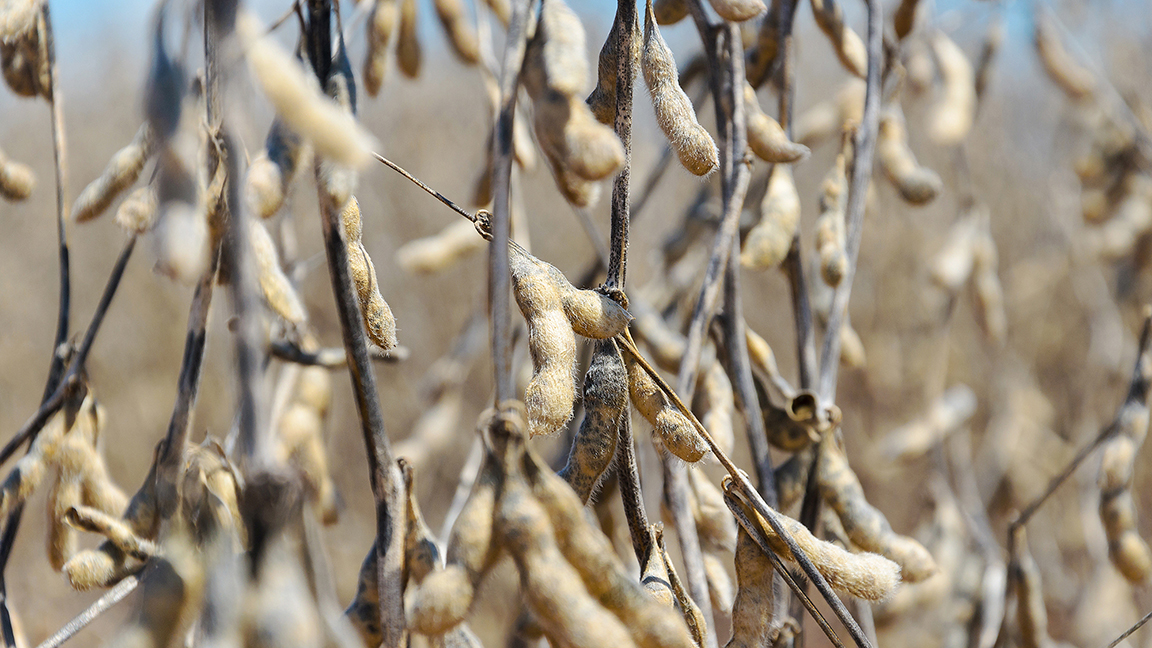Feeding Soybean Hulls to Beef Cattle
Most of the time soyhulls are priced competitively to corn. To determine which is a better buy, compare on a nutritional basis.
August 22, 2011

by Darrell Rankins, Auburn University
Soybeans are primarily processed for their oil, which leads to the generation of two primary byproducts: soybean meal and soybean hulls. Soybean hulls are actually the skin of the soybean, which comes off during processing. These soyhulls are quite small in size and are not very dense. Therefore, many soyhulls are pelleted to increase ease of handling and bulk density. With respect to nutritional value, the loose and pelleted hulls are equal.
Most of the time soyhulls are priced competitively to corn. In order to determine which is a better buy, we must first determine how they compare on a nutritional basis. The two nutrients that we are most interested in are energy and protein.
Corn contains 90% TDN (total digestible nutrients, an index of energy content) and 8%-10% protein. Soyhulls are not as straightforward. In fact, three different publications give them three different energy values. The 1984 National Research Council (NRC) Nutrient Requirements for Beef Cattle publication lists them at 64% TDN, the 1996 NRC publication for beef cattle lists them at 80% TDN, and the latest NRC publication for dairy cattle assigns them a value of 77% TDN. All agree that they contain approximately 12% crude protein.
Why this discrepancy in TDN content? Primarily because of the way in which they are used. If we were to feed a group of cattle a diet that contained 90% corn and another group a diet that contained 90% soyhulls then the results would show that corn would provide 10%-20% faster gains than the soyhulls. However, when we feed diets that contain only a small portion of the diet as corn or soyhulls then the soyhulls provide gains equal to those provided by the corn.
For example, we have a group of cows that have just begun calving. They have been consuming about 25 pounds (lb.) of hay per day, but now that they are calving we need to supplement the hay. Let's compare corn and soyhulls.
We supplement with 5 lb. of corn per day, and the end result is that the cows are now consuming the 5 lb. of corn, but their hay consumption drops to about 18 or 19 lb. per day. Their total energy intake is still greater than it was when they were consuming 25 lb. of hay, but the corn has a negative effect on total intake (now at about 23 or 24 lb.) and will also decrease the digestibility of the hay.
The comparison is that we supplement with 5 lb. of soyhulls per day. Now the final result will be that they will consume the 5 lb. of soyhulls and about 21-22 lb. of hay per day, and the digestibility of the hay may be improved. Even though the soyhulls contain less TDN per pound than does corn, they are equal to the corn as a supplement for cattle consuming forages because of their positive effect on forage intake and digestibility. In addition to the positive effects with regard to the TDN fraction, they also contain more protein than the corn. These same effects can be observed when soyhulls replace corn in a broiler litter-based diet.
In research at Auburn University, we have conducted several studies on the use of soyhulls in beef cattle diets. In summary, these studies revealed that in broiler litter-based diets all of the corn could be replaced with soyhulls and still maintain the same level of performance. For example, when fed to stocker calves or replacement heifers, a 50:50 mix of soyhulls and litter was equivalent to a 50:50 mix of corn and litter. Likewise, brood cows could be fed a 70:30 mix of litter and corn or a 70:30 mix of litter and soyhulls postcalving with equal results on rebreeding interval and conception rates.
In addition, we have used soyhulls as an excellent creep feed. Also, many backgrounded calves have been weaned onto free-choice soyhulls and gained in excess of 2 lb. per day for a 45-day backgrounding period. Soyhulls are extremely palatable and thus make an excellent choice in weaning diets.
Cautions
At high levels of intake (greater than 7 lb. per day), soyhulls are conducive to bloat, and a bloat preventative should be used. A satisfactory method would be to feed a mineral supplement containing an ionophore such as Rumensin® or Bovatec® or mixing the ionophore straight into the feed. Mixing into the feed would be the only option if litter is used because cattle consuming diets containg broiler litter consume very little of the mineral supplement.
Also, always provide some access to long-stem roughage, whether it be hay or grazing. Quality of the roughage is not as important as particle size.
Purchasing the soyhulls in late summer and early fall are the best strategy for purchasing at a bargain price. Always shop around and compare it to the price of corn.
Editor's note: [Lead photo by vbacarin from Getty Images.]
Angus Beef Bulletin EXTRA, Vol. 4, No. 8
Topics: Feedstuffs , Management , Nutrition
Publication: Angus Beef Bulletin


